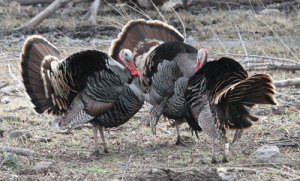
Many of us will enjoy a turkey dinner over the Thanksgiving week and I thought it would be interesting to do a little research on this unique bird. Although there were plenty of turkeys in the area of the first Thanksgiving feast, no one really knows if turkey was on that particular menu. Old journals mention “wild fowl” but that could just as easily have been ducks and geese as they were plentiful as well. Thanksgiving wasn’t established as a national holiday until 1863 when Abraham Lincoln declared it such after the discovery of William Bradford’s journals in 1856 which had been lost for nearly a century. Since he mentions the colonists hunting turkeys in his journals and the Wild Turkey is found throughout the U.S., it seems logical that they became the Thanksgiving meal of choice for many Americans. Most of us learned in grammar school that Benjamin Franklin nominated the Wild Turkey as the national bird but the majestic Bald Eagle won that contest.
Wild Turkeys range from southern Canada south to Mexico and occur in 49 U.S. states. It is too cold in Alaska for them to survive and they were introduced in Hawaii over 100 years ago. They live in all different sorts of forests and in the southwest they are often found in open grassy savannah with small oaks. They eat acorns, other nuts and seeds and survive on buds, ferns, and mosses during the winter. Sometimes they will eat insects and snails to supplement their diet. Although they prefer to run, they can fly too and often roost in trees. You’ve never had such a fright as a big old turkey flying out of a tree to the ground if you startle one while walking through a forest. And they don’t usually come in ones either as they tend to hang around in flocks.
Wild Turkeys nest on the ground in dead leaves around tree bases, under brush piles or thick shrubbery or sometimes in open hayfields. The female uses only plant materials that are already found at the nest site when she scrapes out a shallow depression in the soil. The female lays 4 to 17 eggs and incubates them for 25 to 31 days. The male does not help with incubation and also provides no chick care. The young chicks follow the female until they learn to feed on their own.
Although there were plenty of turkeys when the first British settlers arrived and there are plenty of them now, they suffered severe declines during the nineteenth and early twentieth centuries due to hunting and habitat loss. Captive breeding programs were unsuccessful in restoring turkey populations but successful transplants of wild-caught birds beginning in the 1940’s are what brought turkey populations back.
Although wild and domestic turkeys are the same species, they are very different from each other. Years of selective breeding have resulted in domestic turkeys that are heavier and broader breasted with shorter legs than their wild counterpart. As a result, domestic turkeys can’t fly and they can’t run nearly as fast as wild ones can. Wild turkeys have almost all dark meat which is intensely flavored depending on what they have been feeding on in contrast to domestic turkeys which have almost all white meat.
Except for the Lower Rio Grande Valley, coastal Texas doesn’t have any Wild Turkeys but there are plenty of domestic ones around so if you hear a turkey gobbling, you can be pretty sure it’s in a pen somewhere nearby. While you’re eating your turkey dinner, think about the wild cousins of your domestic turkey peacefully walking through forests searching for their own dinner.
